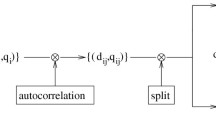Abstract
Molecular superpositioning is an important task in rational drug design. Usually it is the key step in a comparative analysis of molecules by 3D QSAR methods. Also it is helpful for the elucidation ofa pharmacophore and crucial in the attempt to derive a receptor model. Generally speaking, molecular superpositioning can be seen as the analog of molecular docking if the receptor structure is not available, and direct methods are not applicable. Virtual database screening is the computational counterpart to modern experimental techniques like high throughput screening and assaying ofcombinatorial libraries. Both screening techniques have the commongoal to detect active molecules in a large selection of compounds. Usually hundreds of thousands of candidates are to be tested, hence, time is the limiting factor and rapid processing of utmost importance. Descriptor-based methods that usually provide a simple linear encoding of the molecules meet the demands of computational speed and have been used predominantly for the task of virtual screening, for a long time. However, more powerful superposition methods have been developed during the past few years and now begin also to be applicable to screening large databases. Especially incombination with the faster methods, molecular superpositioning as the final step of a filtering protocol provides a powerful tool for virtual database screening. The present work reports on our latest developments of molecular superpositioning techniques and assessing their applicability to virtual database screening.
Similar content being viewed by others
References
Lemmen, C., Hiller, C. and Lengauer, T.: J. Computer-Aided Mol. Design, 12 (1998) 491.
Mestres, J., Rohrer, D.C. and Maggiora, G.M., J. Mol. Graph. Model., 15 (1997) 114.
Crippen, G.M., J. Med. Chem., 22 (1979) 988.
Crippen, G.M. and Havel, T.F., Distance Geometry and Molecular Conformation, Research Studies Press, Taunton, U.K., 1988.
Marshall, G.R., Barry, C.D., Bosshard, H.D., Dammkoehler, R.D. and Dunn, D.A., In Olson, E.C. and Christoffersen, R.E. (Eds.), Computer-Assisted Drug Design, Vol. 112, American Chemical Society, Washington, DC, U.S.A., 1979, pp. 205–222.
Takahashi, Y., Maeda, S. and Sasaki, S.-I., Anals Chimica Acta, 200 (1987) 363.
Martin, Y.C., Bures, M.G., Danaher, E.A., DeLazzer, J., Lico, I. and Pavlik, P.A., J. Comput.-Aided Mol. Design, 7 (1992) 83.
Lamdan, Y. and Wolfson, H.J., In IEEE International Conference on Computer Vision, Tampa, FL, 1988, pp. 238–249.
Nussinov, R. and Wolfson, H.J., Proc. Natl. Acad. Sci. USA, 88 (1991) 10495.
Kabsch, W., Acta Crystallogr., A32 (1976) 922.
Hurst, T., J. Chem. Inf. Comput. Sci., 34 (1994) 190.
Carbó, R., Leyda, L. and Arnau, M., Int. J. Quant. Chem., 17 (1980) 1185.
Hodgkin, E.E. and Richards, G., Int. J. Quant. Chem., Quant. Biol. Symp., 14 (1987) 105.
Thorner, D.A., Wild, D.J., Willett, P. and Wright, P.M., J. Chem. Inf. Comput. Sci., 36 (1996) 900.
Lemmen, C., Lengauer, T. and Klebe, G., J. Med. Chem., 41 (1998) 4502.
Hahn, M., J. Chem. Inf. Comput. Sci., 37 (1997) 80.
Wang, T. and Zhou, J., J. Chem. Inf. Comput. Sci., 38 (1998) 71.
Brint, A.T. and Willett, P., J. Chem. Inf. Comput. Sci., 27 (1997) 152.
Martin, Y.C., Bures, M.G. and Willett, P., In Lipkowitz, B. and Boyd, D.B. (Eds.), Reviews in Computational Chemistry, VCH, Weinheim, Germany, 1990, pp. 265–294.
Johnson, M.A. and Maggiora, G.M. (Eds.), Concepts and Applications of Molecular Similarity, John Wiley & Sons, New York, NY, U.S.A., 1990.
Kubinyi, H. (Ed.), 3D QSAR in Drug Design. Theory, Methods and Applications, ESCOM, Leiden, The Netherlands, 1993.
Dean, P.M., In Dean, P.M. (Ed.), Molecular Similarity in Drug Design, Blackie Academic & Professional, London, U.K., 1995, pp. 1–23.
Good, A.C., In Dean, P.M. (Ed.), Molecular Similarity in Drug Design, Blackie Academic & Professional, London, U.K., 1995, pp. 24–56.
Humblet, C. and Dunbar Jr., J.B., In Venuti, M.C. (Ed.), Annual Reports in Medicinal Chemistry, Vol. 28, Chapter VI: Topics in Drug Design and Discovery, Academic Press, London, U.K., 1993, pp. 275–284.
Klebe, G., In Kubinyi, H. (Ed.), 3D QSAR in Drug Design. Theory, Methods and Applications, ESCOM, Leiden, The Netherlands, 1993, pp. 173–199.
Willett, P., J. Mol. Recogn., 8 (1995) 290.
Brown, R.D. and Martin, Y.C., J. Chem. Inf. Comput. Sci., 36 (1996) 572.
Bures, M.G., In Charifson, P.S. (Ed.), Practical Application of Computer-aided Drug Design, Marcel Dekker, New York, NY, U.S.A., 1997, pp. 39–72.
Matter, H. and Rarey, M., In Jung, G. (Ed.), Combinatorial Organic Chemistry, Wiley-VCH, Weinheim, 2000.
Lemmen, C. and Lengauer, T., J. Comput.-Aided Mol. Design, 14 (2000) 215.
Klebe, G., Mietzner, T. and Weber, F., J. Comput.-Aided Mol. Design, 8 (1994) 751.
Nissink, J.W.M., Verdonk, M.L., Kroon, J., Mietzner, T. and Klebe, G., J. Comput. Chem., 18 (1997) 638.
Lemmen, C. and Lengauer, T., J. Comput.-Aided Mol. Design, 11 (1997) 357.
Lemmen, C., Computational Methods for the Structural Alignment of Molecules. Number 1 in GMD Research Series. GMD - Forschungszentrum Informationstechnik, Sankt Augustin, Germany, 1999.
Jones, G., Willett, P., Glen, R.C. and Taylor, R., J. Mol. Biol., 267 (1997) 727.
Kramer, B., Rarey, M. and Lengauer, T., Proteins Struct. Funct. Genet., 37 (1999) 1.
DAYLIGHT Inc., Mission Viejo, CA, U.S.A. DAYLIGHT Software Manual, 1994.
Briem, H. and Kuntz, I.D., J. Med. Chem., 39 (1996) 3401.
MDL Information Systems Inc., San Leandro, CA, U.S.A. MACCS Drug Data Report (MDDR).
NCI DB release (http://dtp.nci.nih.gov/docs/3d_database/structural_information/-structural_data.html, containing 126,710 structures, 07/01/1998. After conversion to SYBYL's mol2 format and validation 121,491 structures remained.
Author information
Authors and Affiliations
Corresponding author
Rights and permissions
About this article
Cite this article
Lemmen, C., Zimmermann, M. & Lengauer, T. Multiple molecular superpositioning as an effective tool for virtual database screening. Perspectives in Drug Discovery and Design 20, 43–62 (2000). https://doi.org/10.1023/A:1008712519162
Issue Date:
DOI: https://doi.org/10.1023/A:1008712519162




